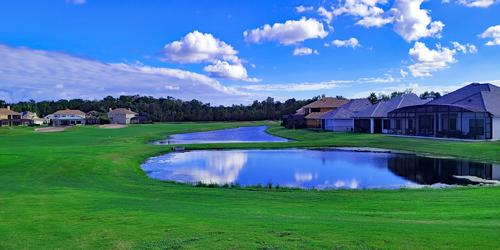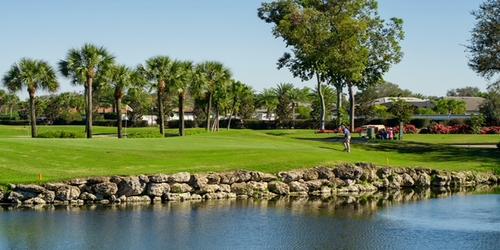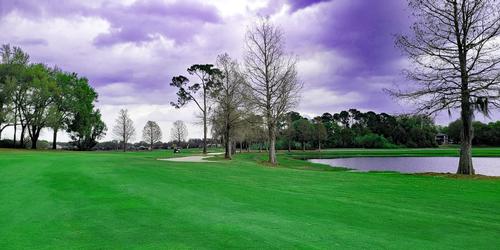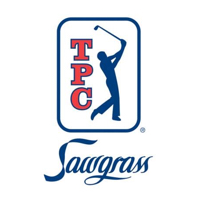
Orange County National
The Best Orlando Has to Offer
By David Theoret
I will admit, there are many pluses and minuses to being an avid golfer and living in Florida; the most obvious being that you get to play golf year round. It's true that while your friends up north are busy tuning up their snow blowers and collecting firewood for the long, cold winter months, you are wearing shorts and polo shorts and hitting golf balls to your heart's content.
When the summer months roll around, they are sometimes the ones having the last laugh. They are not out on the course, playing golf in humidity that is sometimes higher than the temperature which, by the way, rarely dips below 90. As a Floridian, you learn to deal with the hot weather; you learn to drink plenty of water during the round and stay away from the adult beverages - no matter how bad you are playing - until the misery is over.
Another downside to Florida golf is that after a while, many of the courses (and holes) start to look the same. Drive the ball off the tee over protected (this means you can't hunt for golf balls) wetlands and hit an approach shot to a green, usually elevated and guarded by either water or sand. Let's face it; there is only so much a course designer can do with a relatively flat piece of land and that is what you have here in Florida.
Granted, you can find the odd course with some significant (a relative term) elevation changes such as Black Diamond and Skyview at Terra Vista up in the Lecanto area or Brooksville Country Club and Southern Hills around Brooksville. For the most part Florida golfers are left playing courses that are built around wetlands and housing developments (sometimes called "master planned" communities). Don't take this as complaining; I am still blessed to play 12 months a year!
That being said, I recently visited Orange County National just outside Orlando and boy, was I pleasantly surprised. The first thing you notice is how friendly and attentive the staff is; they ask you if you have ever been to OCN before, hoping I think, that you will say "no." Having never been to the facility before that was exactly my answer; I then received pretty much the history of the facility, how it had hosted US open qualifiers a couple of years ago, how there are no houses on the course (a welcome change, especially if you are used to spraying the ball off the tee and waiting to hear the sound of broken glass) and how awesome the practice facility is, (more on that in a minute).
While you are up in the pro shop paying for your round, the cart attendants are busy setting up your cart in the staging area and making sure they set you up with enough water to battle the elements. When you re-emerge from the pro shop they set you up with range balls and direct you to this massive practice area where you can work on every aspect of your game to your heart's content.
The practice area deserves an article all its own. How many golf course websites devote an entire section to the practice facility? As far as I know, OCN is the only one: http://www.ocngolf.com/index.php/overview-of-facility).
Here you will find many interesting facts. Did you know this is where Tiger taped the infamous Nike commercial where he bounces a golf ball off a club several thousand times and then whacks it out of midair right into the hole? About 150 yards from the green on number 10 is where Tiger filmed his Nike commercial with his talking headcover Frank. Remember "Get more forgiving irons, the Nike Pro-Combos?"
It is also home to the PGA Show's Demo Day. This event is held in conjunction with the annual PGA Merchandise Show which is held each year in Orlando at the Convention Center. During this event, 5,000 PGA Professionals visit Orange County National to see and test all of the new equipment and products for the upcoming year. It is estimated that a half million golf balls are hit during that event, all in one day.
The practice facility covers over 42 acres and has a 360 degree hitting area which can accommodate 600 golfers at a time. This is where former Remax Long Drive champion Mike Dobbyn was hitting the ball across the range into the Cobra tent, trying to get Ian Poulter's attention.
There are plenty of targets to aim at. There is a short game area as well as a sand trap area to work on the tougher parts of the game. In case your practice session takes you past the daylight hours, the 25,000 square foot putting green is lit. The green includes an 18-hole putting course and a short game practice area. There is also a short course called "The Tooth" which provides the perfect venue to try out the new shots in your arsenal.
Assuming you have enough energy left in the tank, it's time to tackle the real task at hand; bringing either course to its knees! You have two choices here, the original course, Panther Lake; or its sibling, Crooked Cat. No matter your choice, either (or both) will provide a challenge.
Course Review - Panther Lake
Panther Lake is everything you could want in a golf course. The course plays its way, through native pines, rolling meadows, around and over wetlands and lakes, and up and down elevation changes of up to 60 feet. It is first and foremost a visual delight, reminding you that natural beauty is one of the main reasons you play golf and a major factor in deciding which course to play.
Something else that sets Panther Lake apart from most other Florida courses is that you won't find any houses on the course. What you will find is some of the best examples of nature's beauty. Instead of gazing into someone's backyard, you will likely encounter many species of birds and wildlife which can be enjoyed in tranquil splendor.
Every hole on Panther Lake is unique and will require something different from your shot making arsenal. After your round you will probably be able to recall each hole vividly as they are all so vastly different. You will remember which water hazard you hit into, which bunker was the toughest and how you almost got a birdie (as it was crossing the fairway looking for food).
Gently sloping fairways which are guarded by strategically placed fairway bunkers await your tee shots. Trees and water hazards that make up the framework of many holes. After successfully executing your tee shot, many approach shots will be hit into well-guarded, elevated greens, which are large and feature a lot of undulation; two-putts are not automatic.
Panther Lake opened in 1997. The course plays 7,295 yards from the longest tees for a par of 72. The course rating is 75.7 and it has a slope rating of 137. Phil Ritson, Dave Harman, and Isao Aoki shared in the design of the course.
Memorable Holes:
Number 1: Par 4, 431 yards. You have to like a course that names their golf holes! The "Blue Heron" is a great starting hole; it can make or break your round right off the bat. Your tee shot should favor the left side in order to avoid fairway bunkers; this position also offers the best angle for your approach shot. The green slopes from back left to front right with a lower tier on the front right portion. Par is an excellent score on this hole!
Number 2: Par 5, 495 yards. The "High Hill" is a 515 yard par 5 which is definitely reachable in two from any set of tees. A drive up the left side of the fairway will give you a good look at the green. In the event you do not have a shot at the green, then second shot placement becomes crucial. You will be playing to a multi-tiered green so distance control is a necessity in order to have a makeable putt. Definitely a solid birdie opportunity on number 2.
Number 7: Par 5, 545 yards. "Chad's Way" can be a very difficult par 5. Your tee shot needs to be in the fairway in order to set up the second shot. The second shot will be played over wetlands; be sure to keep it away from wetlands on the left. Choosing the right club on your third shot is critical; you need to be precise in order to carry yet another wetland area. The green is not very deep and out of bounds lurks close behind the green!
Number 9: Par 4, 400 yards. "Trace Lake" poses the toughest tee shot on Panther Lake because the hole features a very narrow fairway that slopes from left to right towards the water. After successfully navigating your tee shot, the approach shot is no picnic either! The green is surrounded by water and bunkers; hitting an extra club might not be a bad idea!
Number 11: Par 3, 203 yards. "Rowdee" is undoubtedly the toughest Par 3 on the course! At 228 yards from the back tees, your tee shot is all carry over hazards and bunkers that surround the front of the green. Long beats short every time on this hole!
Number 13: Par 4, 417 yards. As you stand on the tee of "Pine Walk," you may think you have died and gone to Carolina! This long par 4 is lined by pine trees and bunkers on the left and right side of the fairway. It's all uphill on the tee shot and approach to the green, so an extra club might be a good idea. The green can be tricky as it features a lot of undulation.
Number 18: Par 5, 480 yards. "Hillocks" is a great finishing hole and at 570 yards, requires a tee shot down the right side of the fairway avoiding rough on the left and bunkers on the right. Your second shot needs to be kept right of the fairway. Your approach shot will be to a green that is slightly elevated and slopes right to left.
Last Word: There is nothing boring about Panther Lake; each new hole is as distinct and memorable as the last. The only quality the holes have in common is that each shot demands good thinking and precise execution. Simply put, good shots will be rewarded and bad shots penalized; this is the hallmark of great courses everywhere. If you've ever wondered what it would take to get into Q-school, the tour tees provide such a test. Some of the carries can be quite intimidating and risk/reward approaches can lead to birdies, bogeys, or the unmentionable. From the three forward tees, you'll find shorter carries, easier approaches and wider landing areas. This makes Panther Lake more friendly but no less memorable. For more information on Orange County National, visit their website at http://www.ocngolf.com or give them a call at (407) 656.2626.
Revised: 03/06/2014 - Article Viewed 29,210 Times
- View Course Profile
About: David Theoret
![]() David Theoret has been in the golf and golf travel industry for over 10 years, primarily selling online advertising. For the past seven years, he has also been a golf writer, reviewing golf courses, resorts, destinations, equipment, golf apparel, and training aids - the latter of which never seems to help. David's articles and reviews have been posted on many golf travel and equipment websites.
David Theoret has been in the golf and golf travel industry for over 10 years, primarily selling online advertising. For the past seven years, he has also been a golf writer, reviewing golf courses, resorts, destinations, equipment, golf apparel, and training aids - the latter of which never seems to help. David's articles and reviews have been posted on many golf travel and equipment websites.
Growing up in Southwestern Ontario, Canada, it was naturally assumed he would play hockey. Beginning at the age of 3 and continuing into his late 30's, he did just that. However, after one too many pucks to the head, he realized that golf was a lot easier on the body (whoever said hockey players were slow) and took the game up.
After moving to Florida and accepting a position with TravelGolf Media (now part of GolfNow) his love for the game grew exponentially. Most Saturdays you will find him on a course somewhere in Florida or on the practice range reinforcing his bad habits. David plays to a 10 handicap - unless there is money involved in which case it goes considerably higher. He currently resides in Lakeland, FL with his wife Belinda and their two "kids", Madyson and Molly.
Contact David Theoret:
GolfTrips.com - Contributor











